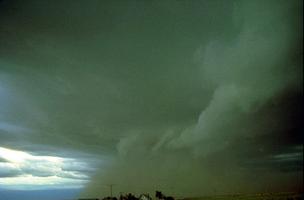
Weathering
Weathering processes cause the disintegration of rock materials in the Earth's uppermost layer. These mechanisms provide vital links between organic and inorganic elements of ecosystems and thus are crucial for the maintenance of life on Earth. Although in reality weathering processes are highly interactive, they may be grouped into 2 main types: mechanical (ie, physical) and chemical. Mechanical processes break up rock masses into fragments but cause no fundamental mineral alterations. Disintegration may be triggered in many ways. The long-term unloading of rock that was originally formed at great depths below the Earth's surface often produces sheetlike cracks (dilatation joints). Intense heating of rock may set up expansion stresses sufficient to split boulders and separate sheets or flakes. Frost wedging is effective where there are freeze-thaw cycles, rapid subfreezing temperature declines, and significant free water in cracks and pore spaces. Particularly in forest environments, plant roots promote rock wedging by their penetration and growth; burrowing animals also contribute to the decomposition of earth materials. Salt weathering, by the growth and thermal expansion of salt crystals in rock and soil interstices, is probably of some importance in coastal zones, and possibly in polar desert ecosystems like those of Canadian high-arctic latitudes.
Fragmented rock materials formed by mechanical weathering are normally larger than clay particles. These materials constitute major sources of sediment for later erosion, transportation and deposition under the impetus of gravity, wind, water or ice. To varying degrees, these relatively coarse-textured rock fragments also aid in the development of a soil cover at the Earth's surface. As mechanical weathering progresses through geologic time, increased surface areas per-unit volume of rock are developed. Chemical weathering processes are assisted by the consequent exposure of new minerals to their attack.
Chemical weathering involves the decomposition or rotting of rock by mineral transformations and by partial resyntheses of secondary weathering residues (including clay minerals). The major processes of chemical weathering are hydration-dehydration and hydrolysis (involving action of water), oxidation (involving oxygen), carbonation (activity of carbon dioxide dissolved in water), chelation (combination with a metal), fixation, reduction and solution. As the conversion of primary to secondary minerals continues, clay minerals accumulate in soil. These minerals are extremely important in the functioning of soil systems, particularly as base-exchangers between vegetation and mineral soil constituents. The amount and dominant types of clay minerals present in different soils also exert strong controls on water quality and transmission. Some clay minerals expand greatly when water saturated; others are comparatively water stable. Partly because of this and other weathering effects, slope stability generally declines as rock decomposition intensifies, the clay content of subsoil materials increases and rock shear strength below the soil is diminished by rotting. Many types of slope failure are directly attributable to the long-term effects of subsurface weathering processes (see landslide, rockslide).
Thus, weathering may be viewed as simultaneously performing a range of destructive and constructive functions. The destructive facets of rock decay through time provide the constructive skeleton of soil development (pedogenesis) and replenishment. In Canada, good expressions of deep, relatively intense chemical weathering occur in the warmest, moist environments of western BC and southern Ontario.
Many factors help determine the combinations of dominant weathering, sedimentary and pedogenic processes typifying different regions. Prevailing climate and vegetation types are of paramount importance. Wherever severe water shortages, extreme temperature regimes, or both, occur, many chemical weathering processes are inhibited and mechanical weathering achieves greater prominence. In Canada such ecosystems are best exemplified by high latitude tundra and by regions above the treeline in alpine zones. Even on stable sites in these areas, soil development is meagre because weathering processes are not able to produce significant soil-clay complexes. Predominant vegetation types have a closely reciprocal relationship with soils and weathering. Species which are not particularly base demanding, but which produce abundant organic acids, will concentrate leaching in the topsoil. Only the most resistant primary minerals, such as quartz, can repel the onslaught of organic acids, and secondary weathering products (including clays) are moved to some depth below the topsoil. Many boreal forest soil types are related to this general weathering regime.
Mineral susceptibility to chemical attack is highly variable, but rocks with high proportions of quartz are generally more resistant to weathering than others. Thus, the geologic setting of particular regions partially controls the effectiveness of the weathering processes (see Geological Regions). Geologic "inheritance" may assume great importance: certain types of sedimentary environments favour accumulation of clays; others concentrate quartz-rich sands or gravels. Further, because much of Canada has only recently (in geologic time) emerged from the covering masses of Pleistocene ice sheets (see glaciation), weathering and other pedogenic processes have had only a few thousand years in which to work. See also Landform Regions.

 Share on Facebook
Share on Facebook Share on X
Share on X Share by Email
Share by Email Share on Google Classroom
Share on Google Classroom


